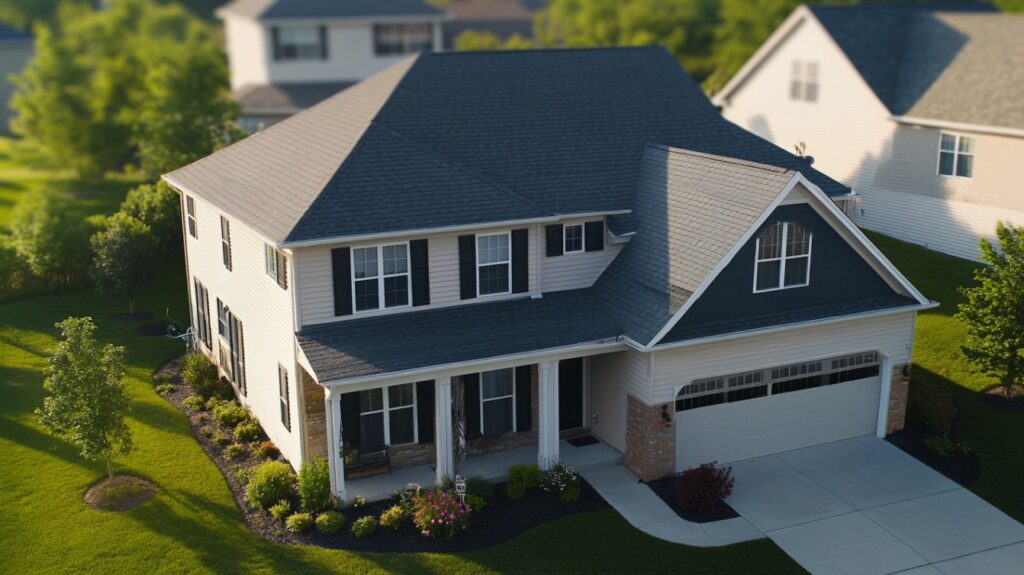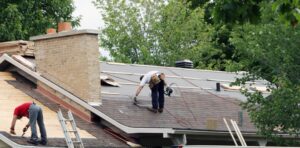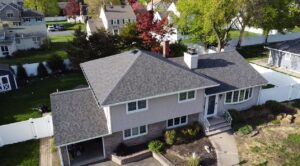If you’ve been researching a new roof for your Northern New Jersey home, you’ve probably heard the term roof pitch more than once. But what is roof pitch exactly, and how does it affect your project cost? As a trusted residential roofing company, we get this question often—especially from homeowners wondering if a steeper roof automatically means a bigger price tag.
The short answer: yes, a steeper roof often costs more to install or replace. But the “why” behind that answer involves more than just the roof’s angle. In this roofing slope guide, we’ll explain the roof angle meaning, go over common roof pitch types, and break down how slope affects pricing here in North Jersey.
Roof Pitch Explained
In the simplest terms, roof pitch describes how steep your roof is. It’s usually expressed as a ratio—how many inches the roof rises vertically for every 12 inches it runs horizontally. For example, a 4/12 pitch means your roof rises 4 inches for every 12 inches of horizontal run, while a 12/12 pitch is much steeper, rising 12 inches for every foot of run.
This slope isn’t just about looks—it influences everything from how well your roof sheds snow and rain to what materials are best suited for it. In Northern NJ, where we see heavy winter snow and strong storms, pitch plays a big role in both performance and long-term durability.
Roof Angle Meaning in Practical Terms
Beyond the numbers, your roof’s angle determines:
- Water and Snow Shedding – Steeper roofs naturally shed snow and water faster, reducing the risk of leaks and ice dams.
- Material Compatibility – Certain roofing materials, like slate or cedar shakes, are better suited to specific pitches.
- Aesthetic Appeal – The slope changes your home’s look, from the sleek lines of a low-slope roof to the dramatic profile of a steep gable.
- Usable Attic Space – Higher pitches can provide more headroom for storage or living areas.
Roof Pitch Types Common in Northern NJ
While there are many variations, most Northern New Jersey homes fall into one of these common roof pitch types:
- Low-Slope (2/12 to 4/12) – Found on some ranch homes and modern designs; requires careful waterproofing.
- Medium-Slope (5/12 to 8/12) – Common on Colonial, Cape Cod, and traditional suburban homes.
- Steep-Slope (9/12 and above) – Popular for Victorian, Tudor, and some custom homes; highly effective for snow shedding.
Why Steeper Roofs Tend to Cost More
So, does a steeper roof really mean a higher bill? In most cases—yes. Here’s why:
1. Labor Intensity
Working on a steep-slope roof is more physically demanding and requires additional safety measures. Crews often need harnesses, scaffolding, or roof jacks to safely navigate the pitch, which increases labor time and complexity.
2. Installation Speed
On a lower slope, roofers can move more quickly and efficiently. On a steep slope, every step is slower for safety and precision, which extends the project timeline.
3. Material Waste
Steeper roofs can require more cutting and fitting of shingles or panels, leading to slightly higher material waste—something factored into the estimate.
4. Surface Area
A steep roof has more surface area than a low-slope roof covering the same floor plan, which means more materials and labor are needed overall.

Additional Cost Factors Beyond Pitch
While slope plays a role in your roofing investment, it’s just one factor. Your total cost will also depend on:
- Roof Size – Larger roofs require more materials and labor.
- Material Choice – Asphalt shingles, metal panels, cedar shakes, and slate all have different price points.
- Roof Complexity – Multiple dormers, valleys, and hips can add complexity to the installation.
- Structural Repairs – If decking or framing needs reinforcement, that will add to the cost.
- Accessibility – Tight property lines or difficult access for equipment can increase labor time.
Benefits of a Steeper Roof
While steeper roofs may cost more upfront, they do offer advantages worth considering:
- Better Water and Snow Shedding – Reduces the risk of leaks, ice dams, and snow buildup.
- Longer Material Lifespan – Shingles on steep slopes tend to dry faster after rain or snow, which can extend their lifespan.
- Improved Attic Space – Potential for more usable space under the roof.
- Enhanced Curb Appeal – Steep slopes can give a home a more dramatic and distinctive appearance.
Making the Most of Your Roofing Investment
If your home’s design calls for a steeper roof, there are ways to maximize value and control costs without compromising quality:
- Work with an Experienced Contractor – Steep-slope projects require specialized skills. Choose a roofer who regularly works on the pitch type you have.
- Select the Right Materials – Some roofing materials perform better on certain slopes; your contractor can guide you to the best options for your pitch and climate.
- Plan Ahead – Scheduling your project in advance can give you more flexibility to take advantage of seasonal promotions or off-peak pricing.
- Bundle Repairs or Upgrades – If you’re planning gutter replacement, skylight installation, or attic ventilation upgrades, combining them with your roof project can save time and money.
Quick Roof Pitch Reference Chart
Here’s a simple visual breakdown for what is roof pitch and how it’s typically classified:
| Pitch Ratio | Classification | Common Uses |
| 2/12 – 4/12 | Low-Slope | Ranch homes, modern designs |
| 5/12 – 8/12 | Medium-Slope | Traditional suburban homes |
| 9/12 + | Steep-Slope | Victorian, Tudor, custom designs |
Deciding If Roof Pitch Changes Are Worth It
If you’re replacing your roof, you may wonder if it’s worth altering the slope to change the look or improve performance. While possible, changing roof pitch often involves significant structural modifications, which can be expensive. In most cases, keeping your existing roof pitch and upgrading materials is the more cost-effective choice.
The Bottom Line on Steeper Roof Costs
A steeper roof will usually cost more to replace or install due to the additional labor, safety measures, and materials involved. However, it also brings benefits like better weather performance, longer material life, and increased curb appeal—especially important in a place like Northern New Jersey where winter weather can be tough on homes.
At Haven Roofing Company, we believe that understanding your roof pitch—and how it affects both cost and performance—is key to making a confident decision. Whether your home has a low slope, a dramatic steep pitch, or something in between, our team can guide you through the options that fit your style, budget, and long-term needs.
Ready to Talk About Your Roof?
If you’re wondering how your roof’s slope will affect your replacement project, we’re here to help. At Haven Roofing Company in North Jersey, we combine expert craftsmanship with honest guidance to make sure you get the best results—no matter the pitch.
Contact us today to schedule your free roof inspection and learn more about the perfect roofing solution for your home.



